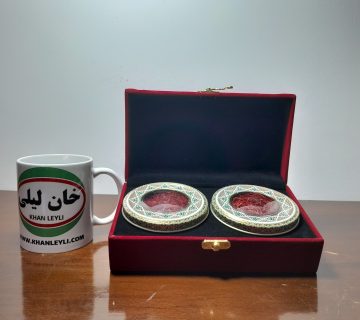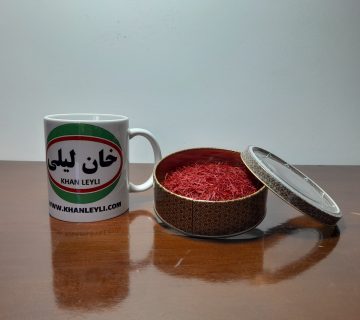The saffron plant (Crocus sativus) is a perennial flower that belongs to the iris family (Iridaceae). It is known for being the source of saffron, one of the world’s most valuable and sought-after spices. Here are key characteristics of the saffron plant:
- Appearance: The saffron plant is a small herbaceous perennial that grows to a height of about 20-30 cm (8-12 inches). It produces slender, grass-like leaves and bears a single, purple to lilac-colored flower.
- Flower Structure: The saffron flower has a central, trumpet-shaped structure known as the perianth tube, and within this tube are the three vivid red stigmas, which are the female reproductive organs. These red stigmas are the saffron threads used as the spice.
- Cultivation: Saffron plants are typically grown from bulbs (corms) and require well-drained soil. The plant blooms in the fall, usually from October to November, depending on the region and climate.
- Harvesting: Saffron is harvested during the flowering season. Each flower produces only a small number of red stigmas, and they must be carefully hand-picked. The harvesting process is labor-intensive, as it takes a large number of flowers to produce a relatively small quantity of saffron.
Saffron is primarily cultivated in specific regions known for their conducive climate and soil conditions. The areas where saffron is grown the most include:
- Iran: Iran is the largest producer of saffron globally, and a significant portion of the saffron is cultivated in the Khorasan region.
- India: India, particularly the region of Jammu and Kashmir, is another major producer of saffron. The saffron cultivated in this region is often referred to as “Kashmiri Saffron.”
- Spain: Spain, especially the La Mancha region, is known for saffron cultivation. Spanish saffron is well-regarded for its quality.
- Greece: Greece, particularly in the region of Kozani, is also a notable producer of saffron.
- Morocco: Saffron is cultivated in certain regions of Morocco, such as Taliouine, where the climate is suitable for saffron production.
These regions have specific climatic and soil conditions that favor saffron cultivation, and traditional farming practices are often employed to maintain the quality of the spice. Saffron cultivation is a delicate process, and the plant is sensitive to factors such as temperature, sunlight, and soil composition.
Saffron flower shape
The saffron flower with the scientific name Crocus sativus has a distinct appearance. The key features of saffron flower are as follows:
- Petal:
– The saffron flower usually has six purple colored petals. These petals come out from the central part of the flower.
- stigma:
– The most valuable part of the saffron flower is the stigma, which is a thread-like structure that extends from the center of the flower. The stigma is the part of the flower that is harvested to produce saffron spice. Each flower usually produces three red stigmas.
- Style:
– The style is a narrow stem that connects the stigma to the rest of the flower. The pale colored part is from saffron threads and is not usually used in spices.
- Color:
– The saffron flower is characterized by its vibrant purple color. This color is especially prominent in the petals and creates a beautiful contrast to the red stigmas.
- Size:
– The saffron flower is relatively small in size. Its diameter is usually a few centimeters.
- Life cycle:
– The saffron flower blooms in autumn. The flowers emerge from the corms (bulb-like structures) of the saffron saffron plant.
Harvesting saffron involves plucking the delicate red stigmas from the flowers. Saffron is one of the most expensive spices in the world due to the laboriousness of harvesting saffron and the fact that each flower produces only a small amount of saffron.
How to use saffron
Saffron is a versatile spice that adds a unique flavor, color, and aroma to a variety of dishes. Here are some common methods for using saffron in cooking:
- Infusion:
– Grind a few saffron threads using a mortar and pestle.
– Steep the ground saffron in a small amount of warm liquid, such as water, milk, or broth. This allows the saffron to release its flavor and color.
– After 15-20 minutes, the liquid will take on the distinctive hue of saffron. Use this infused liquid in your recipe.
- Direct Addition:
– Add whole or crushed saffron threads directly to a dish while it is cooking.
– The heat will activate the saffron, infusing its flavor and color into the food.
– Crush the saffron threads with your fingers or use a mortar and pestle before adding them to enhance their potency.
- Soaking:
– Soak saffron threads in a small amount of warm water, milk, or broth for about 15-20 minutes.
– The soaked saffron can then be added to the recipe along with the soaking liquid.
- Grinding:
– Grind saffron threads into a powder using a mortar and pestle or a dedicated spice grinder.
– The powdered saffron can be added directly to dishes or used for infusions.
- Dry Roasting:
– Lightly dry roast saffron threads in a pan over low heat for a minute or two.
– Be cautious not to burn the saffron. Roasting can enhance its flavor.
– After roasting, crush the threads and use them in your recipe.
- Saffron Water:
– Prepare saffron water by soaking saffron threads in warm water.
– This saffron-infused water can be used in various recipes, such as rice dishes or desserts.
- Dissolving in Broth or Stock:
– Dissolve saffron threads in warm broth or stock before adding it to dishes like paella or risotto.
– The saffron-infused broth imparts its flavor and color to the entire dish.
- Baking and Desserts:
– Add saffron to baking recipes, such as cakes, cookies, or pastries, to give them a unique flavor and a golden hue.
Remember that saffron is potent, and a little goes a long way. Start with a small amount and adjust according to your taste preferences. Additionally, store saffron in a cool, dark place in an airtight container to preserve its flavor and color.
Tips for better coloring of saffron
To ensure that saffron imparts the best color to your dishes, it’s important to handle and use it properly. Here are some key points to observe when using saffron for optimal color:
- Quality of Saffron:
– Start with high-quality saffron. Look for saffron threads that have a deep red color, a strong aroma, and a robust flavor. Premium saffron is more likely to provide a rich and vibrant color.
- Storage Conditions:
– Store saffron in a cool, dark place, away from direct sunlight. Exposure to light and heat can degrade the color and flavor of saffron over time.
- Grinding or Soaking:
– To enhance color extraction, consider grinding or soaking saffron before use. Grinding saffron threads into a powder or soaking them in a small amount of warm liquid (water, milk, or broth) can help release the color more effectively.
- Temperature of Liquid:
– When soaking saffron, use a warm (but not boiling) liquid. The warmth helps the saffron release its color and flavor. Avoid using boiling water directly, as excessive heat may degrade some of saffron’s delicate compounds.
- Steeping Time:
– Allow saffron to steep in the liquid for a sufficient amount of time. Steeping times can vary but typically range from 15 minutes to several hours. Longer steeping times often result in a more intense color.
- Crushing Threads:
– Before adding saffron to a dish, consider crushing the threads between your fingers. This can help release more of the saffron’s pigments and enhance color dispersion.
- Addition During Cooking:
– Add saffron early in the cooking process to allow its color and flavor to infuse the dish thoroughly. This is especially important for dishes with longer cooking times.
- Avoid Direct Heat:
– While saffron is cooking, avoid exposing it to direct heat for extended periods, as this may diminish its color. Instead, incorporate saffron into dishes that involve simmering or gentle cooking.
- Balance the Amount:
– Achieving the right balance is crucial. Use saffron judiciously to avoid overpowering the dish. Even a small amount of high-quality saffron can contribute a significant color impact.
- Pairing with Ingredients:
– Consider the ingredients you are combining with saffron. Some ingredients, like acidic components (lemon juice, tomatoes), may enhance the color, while others may influence it differently.
By paying attention to these points, you can make the most of saffron’s color properties and ensure a visually appealing and vibrant result in your culinary creations.
Uses of saffron
Saffron is a versatile spice that is used in various culinary and non-culinary applications, thanks to its distinctive flavor, aroma, and vibrant color. Here are some common uses of saffron:
- Culinary Uses:
– Flavoring Rice and Grains: Saffron is often used to flavor rice dishes, such as paella and biryani, providing both color and a unique taste.
– Infusing Liquids: Saffron threads are infused in warm liquids (water, milk, or broth) to extract their flavor and color, which can then be added to soups, stews, and sauces.
– Baking: Saffron can be incorporated into various baked goods, including bread, cakes, and cookies, to add a distinctive flavor and color.
– Desserts: Saffron is used in the preparation of desserts like ice cream, custards, and puddings to enhance their flavor and provide a rich color.
– Spice Blends: Saffron is a key ingredient in some spice blends, such as garam masala and bouillabaisse seasoning.
- Beverages:
– Tea: Saffron is infused into hot water or tea to create saffron-infused beverages, which are popular in some cultures for their unique taste and potential health benefits.
- Medicinal Uses:
– Traditional Medicine: Saffron has been used in traditional medicine for various purposes, including improving mood, promoting relaxation, and addressing certain health conditions. However, it’s essential to consult with a healthcare professional before using saffron for medicinal purposes.
- Aromatherapy:
– Scented Products: Saffron’s distinct aroma makes it a desirable ingredient in perfumes, potpourri, and scented oils.
- Coloring Agents:
– Natural Dye: Saffron is a natural dye that imparts a rich yellow-orange color to foods, textiles, and even Easter eggs.
- Beauty and Skincare:
– Face Masks and Scrubs: Saffron is sometimes used in beauty routines. It can be added to face masks or scrubs for potential skin benefits.
- Religious and Cultural Uses:
– Religious Ceremonies: Saffron is used in some religious ceremonies and rituals in various cultures.
- Traditional and Festive Dishes:
– Special Occasions: Saffron is often reserved for special occasions and festive dishes, enhancing the significance of the meal.
While saffron is prized for its culinary applications, it’s important to use it judiciously due to its strong flavor and high cost. Whether used in savory dishes, desserts, beverages, or cultural practices, saffron adds a touch of luxury and uniqueness to a wide range of experiences.
Saffron gold: benefits of saffron for the body
Saffron, often referred to as the “golden spice,” is not only valued for its distinctive flavor and color but also for its potential health benefits. While more research is needed to fully understand the extent of these benefits, saffron has been associated with various positive effects on the human body. Here are some potential health benefits of saffron:
- Antioxidant Properties:
– Saffron contains compounds such as crocin, crocetin, and safranal, which exhibit antioxidant properties. Antioxidants help neutralize free radicals in the body, reducing oxidative stress and cellular damage.
- Mood Enhancement:
– Saffron has been studied for its potential antidepressant effects. It may influence neurotransmitters in the brain, such as serotonin, contributing to improved mood.
- Anti-Inflammatory Effects:
– Compounds in saffron, particularly crocetin, have shown anti-inflammatory properties. This may be beneficial for conditions involving inflammation, such as arthritis.
- Improved Memory and Cognitive Function:
– Some studies suggest that saffron may have cognitive-enhancing effects. It may improve memory and learning abilities, potentially benefiting cognitive function.
- Cardiovascular Health:
– Saffron has been investigated for its potential cardiovascular benefits. It may help lower blood pressure, reduce cholesterol levels, and have positive effects on overall heart health.
- Weight Management:
– Preliminary research indicates that saffron may have potential benefits for weight management. It may help reduce appetite and contribute to better eating habits.
- Menstrual Health:
– Saffron has been traditionally used to alleviate symptoms of premenstrual syndrome (PMS) and may help regulate menstrual cycles.
- Eye Health:
– Saffron may have protective effects on retinal cells. It has been explored for its potential role in preventing age-related macular degeneration (AMD) and promoting overall eye health.
- Anticancer Properties:
– Some studies suggest that saffron may have anticancer properties, inhibiting the growth of cancer cells and inducing apoptosis (programmed cell death).
- Anti-Diabetic Effects:
– Research indicates that saffron may have hypoglycemic effects, helping to lower blood sugar levels. This can be beneficial for individuals with diabetes.
- Antimicrobial Properties:
– Saffron has demonstrated antimicrobial properties, which may contribute to its traditional use in combating infections.
It’s important to note that while saffron shows promise for various health benefits, individual responses can vary, and more research is needed to establish the efficacy and safety of saffron conclusively. Moreover, saffron should not be used as a sole treatment for serious medical conditions, and consultation with a healthcare professional is advisable, especially for individuals with existing health concerns or those taking medications.








No comment